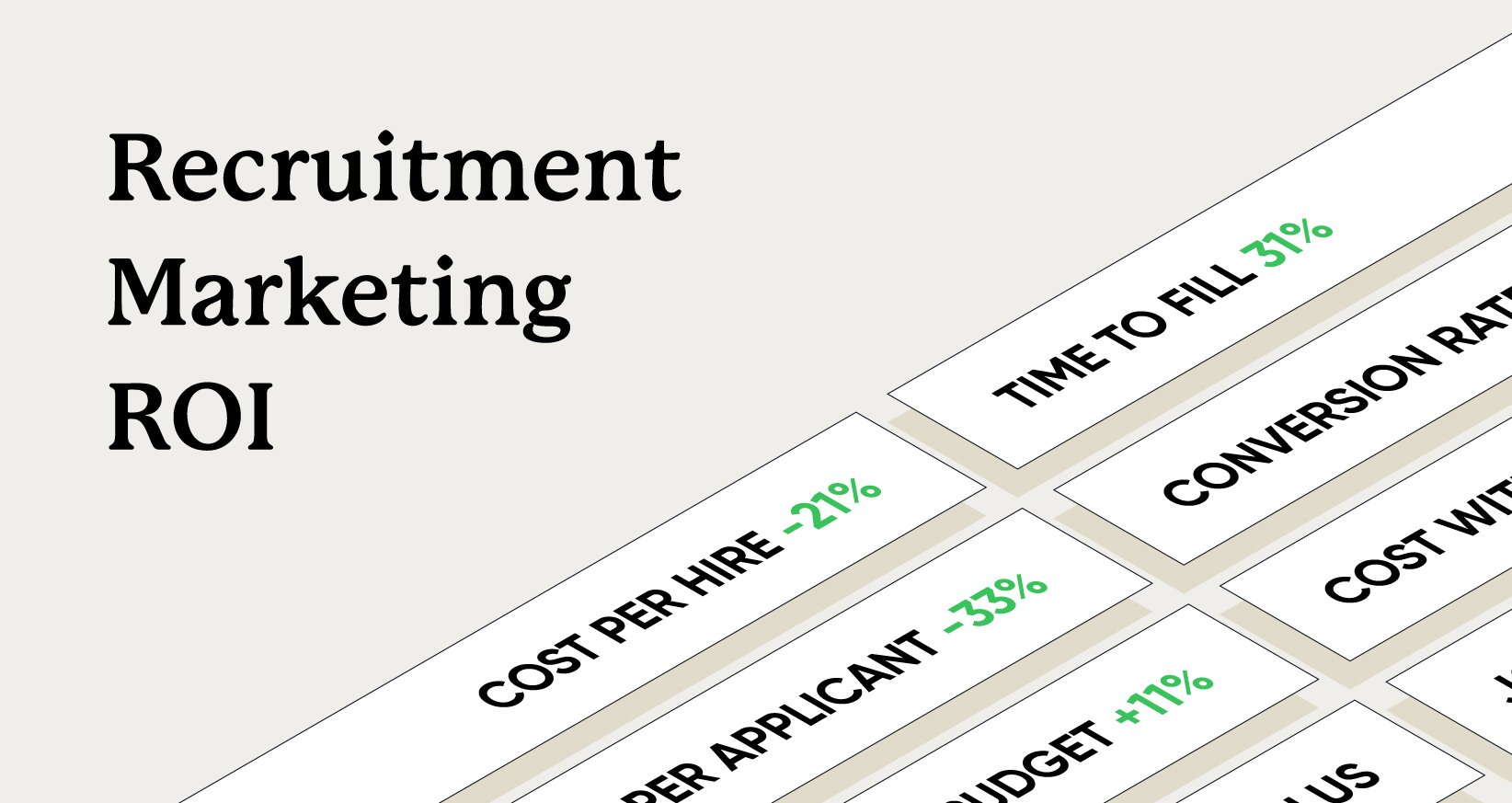In the face of economic uncertainty, talent acquisition leaders are often confronted with substantial cuts to their recruitment budgets. A recent survey of 500 company executives revealed that 99% plan to reduce costs this year due to the anticipated recession, with 61% intending to decrease their recruitment and hiring expenditure.
This trend stems from the difficulty many executives face in discerning the return on investment (ROI) in talent acquisition. They often perceive the recruitment budget as a necessary expense during hiring surges but deem it expendable during downturns. As a talent acquisition leader, it's your responsibility to challenge this perception.
Demonstrating the return on investment (ROI) of Recruitment Marketing strategy can be a bit tricky, as you've likely experienced yourself. In this article, we’ll explain how to use data to show that investing in recruiting is just as critical to a business’s success during downturns as it is during growth phases.
How does recruitment marketing save you $$$?
Recruitment marketing enhances every interaction you have with a prospective candidate - including content on your careers site, social media, emails, and tailored job ads - to transform job hunters and passive candidates into applicants. By optimizing and automating these channels, recruitment professionals can reduce advertising costs while maintaining the same applicant volume. This consistent influx of applicants allows recruiters to select from a wide range of talent, contributing to the creation of high-quality talent pools.
Recruitment marketing draws from the concepts of marketing automation and content marketing. These strategies are widely used in the marketing sector, with recent research from HubSpot indicating that 68% of marketers employ marketing automation, and 79% of high-performing companies have been utilizing marketing automation for at least three years. Marketers using automation software generate 2x the number of leads and are 2x as effective.
Recruitment marketing leverages the same tactics as your marketing team but with a focus on optimizing every interaction a potential candidate has with your company instead of targeting potential customers.
Similar to a customer's journey, a potential candidate navigates through your SEO-optimized career site, receives personalized content based on their browsing history, applies for a position, and is consistently engaged through regular communication. At each step of this journey, recruitment marketing utilizes top-notch marketing strategies to optimize these touchpoints.
Connecting Recruitment Marketing KPIs to business goals
To underscore the strategic value of talent acquisition, it's crucial to demonstrate how recruitment contributes significantly to your business's overall success. This can be achieved by tracking key recruitment metrics and correlating this data with business initiatives such as revenue growth, customer satisfaction, and cost reduction. What data should you measure to gouge the success of your recruitment marketing efforts?

Cost per Applicant or CPA
Recruiting can be costly, especially when it comes to advertising open positions on job boards and maintaining a career site. This is where Cost Per Applicant (CPA) comes into play. In marketing, it's referred to as Cost Per Lead (CPL), which is calculated by dividing the total advertising expenditure for a campaign by the total number of leads generated. The resulting figure is the cost incurred to acquire each lead in that campaign.
High Cost Per Lead (CPL) in marketing campaigns is often a sign of poor targeting or weak Call To Action (CTA), resulting in low conversion rates. On the other hand, campaigns with a low CPL are highly desirable as they are effective in engaging and converting a large number of visitors into leads.
Recruitment marketing operates under the same principles as marketing automation, where a high cost per lead (CPL) suggests poor targeting and weak call-to-actions (CTAs). The same applies to recruitment, where an unoptimized careers site or job board will result in a high cost per applicant (CPA), while optimized recruitment channels will result in a low CPA.
With recruitment marketing, you can decrease your advertising spend by 50% while increasing your conversion to applicant rate by 2x, resulting in significant savings.
Social Media Metrics: The Digital Word-of-Mouth
Social media has become a powerful tool for spreading the word about your company. It's like the digital version of word-of-mouth. Here are some metrics you should be tracking:
- Reach: How many people are seeing your posts?
- Engagement: How many people are interacting with your posts?
- Impressions: How many times are your posts being viewed?
- Audience: Who is engaging with your posts?
- CTR (Click-through rate): How many people are clicking on your posts?
By tracking these metrics, you can understand what type of content resonates with your audience and what doesn't. Remember, it's not about throwing content at the wall and seeing what sticks. It's about measuring and optimizing.
PPC Metrics: Paying for Visibility
Paid online advertising is a great way to get your brand in front of potential recruits. Here are some metrics to track:
- Clicks: How many people are clicking on your ads?
- CPC (cost per click): How much are you paying for each click?
- Submissions: How many people are applying through your ads?
- Hires compared to spend: How many hires are you getting for the amount you're spending?
Whether the goal is to build a more favorable reputation as an employer, attract high-quality candidates, decrease cost-per-hire, save recruiting time and expenses, or all the above – these are the metrics to analyze based on where your candidates sit in the funnel. No matter where your candidates are in the recruitment funnel, whether they're still learning about your brand, beginning to show interest, or have already become applicants, it's crucial to analyze metrics in order to achieve your talent acquisition goals.
Time-to-Hire: Speed Matters
Time-to-hire is the duration from when someone applies to when they accept your offer. A shorter time-to-hire means a more efficient process and increases your chances of capturing top talent. After all; the best candidates are off the market in an average of 10 days!
By analyzing historical data, you can uncover how reducing time-to-fill impacts your company's revenue growth. A shorter hiring cycle implies quicker access to skilled talent, enabling your company to capitalize on business opportunities and expedite growth. By juxtaposing revenue data against time-to-fill metrics, you can illustrate the positive correlation between efficient hiring and increased revenue generation.
Quality-of-Hire and Customer Satisfaction
Connecting the measure of hire quality with customer satisfaction indicators can offer a persuasive case for the strategic influence of recruitment. By analyzing information on customer responses, scores, or retention percentages, those in charge of talent acquisition can establish links between the quality of employees recruited and the levels of customer satisfaction. Superior employee abilities, knowledge, and harmony with company values can lead to improved customer interactions, resulting in increased satisfaction and enhanced customer loyalty.
Manual Time: Efficiency is Key
Consider the time it takes you to fill an open position. This includes posting the position, promoting it, reviewing resumes, scheduling interviews, and more. With digital tools like email automation and PPC, recruitment marketing can significantly reduce the manual effort required in the hiring process.
So, a recruitment marketing strategy can cut down on the manual effort you have to put into the hiring process. But you’ll only know this if you keep track of it!
Larger Candidate Pool: Quantity and Quality
Finally, track the size of your candidate pool. If your recruitment marketing efforts aren't leading to more candidates applying, it's time to reassess and optimize.
Better yet, ask what you can do to tweak the program to get the results you want. You can find the answer to that question by looking at the metrics above. If one metric is performing below the others, that’s where to start your optimization efforts.
Conclusion
In conclusion, the strategic value of recruitment marketing, particularly during economic uncertainty, cannot be overstated. By optimizing every interaction with potential candidates, recruitment marketing reduces costs and ensures a consistent flow of high-quality applicants. Key metrics such as Cost per Applicant, social media engagement, time-to-hire, and quality-of-hire provide valuable insights into the success of your recruitment efforts.
SmartDreamers can be your partner in this journey, offering solutions that leverage marketing automation and content marketing principles to enhance your recruitment strategy. By using SmartDreamers, you can improve your ROI, save on costs, and build a robust talent pool. Don't let economic downturns hinder your recruitment efforts. Invest strategically in recruitment marketing with SmartDreamers and see the difference it makes. Get in touch with us today to learn more.








